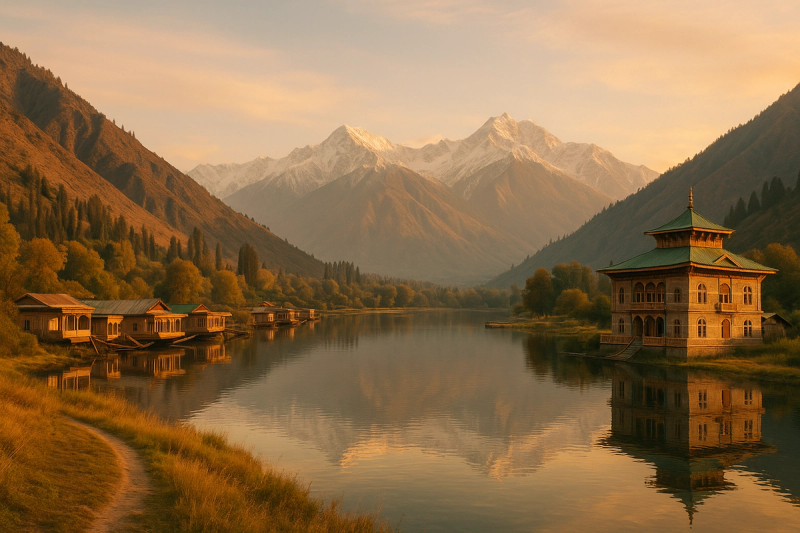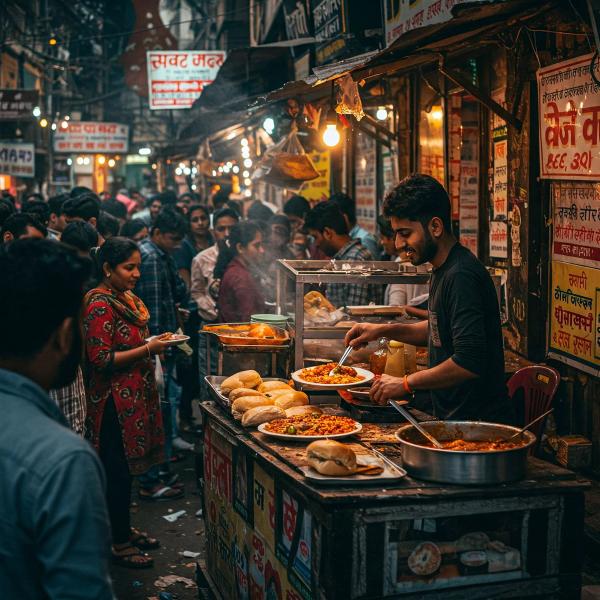10 Adventure Activities in Kashmir Beyond the Ordinary — the stuff I actually did (and a couple I almost chickened out of)#
So, Kashmir. The name alone feels like poetry, na? I went with a backpack, two layers of thermals, and exactly zero chill because who even stays calm when you land in Srinagar and the air smells like fresh cedar and kahwa. I’m from Delhi, have done Himachal like five times, and honestly thought I knew mountains. Nope. Kashmir does this weird thing where even the silence sounds like music. Quick vibe check before the adventure stuff: tourist zones like Srinagar–Gulmarg–Pahalgam–Sonamarg are pretty sorted right now, and hospitality is next level. There’s the army around, lots of checkposts — just carry your ID everywhere and respect local rules. As of early 2025, most operators are running regular seasons, Gondola is open when weather allows, internet works fine in town, and NH44 is… well, NH44. Landslides happen, traffic advisories drop, you watch BRO trucks and pray a little. Normal mountain life. If you’re sensible, you’re safe.¶
Best time? Depends on what you want to do. Winter (Jan–March) is for snow junkies: skiing, snowshoeing, ice stuff. Spring (Apr–May) tulips and soft treks, summer (June–Sept) for long alpine lake hikes, rafting, mountain biking. Autumn (Oct) is ridiculously golden. Budget wise you can do homestays and shared rides and keep it under ₹2,500–₹4,000 per day, or go fancy — Gulmarg resorts can hit ₹12k–₹18k easy in peak. Houseboats range around ₹1,500–₹6,000 a night depending on bling levels. Guides are worth every rupee, trust me.¶
1) Sunrise Snowshoe Walk in Gulmarg — quiet, crunchy, unreal#
If you think Gulmarg is only for skiers, yaar, go at dawn with snowshoes. I rented a pair for around ₹600 from a tiny shop near the market and followed a local guide (₹2,500-ish for half day) through pine glades towards Ningle Nallah. The snow makes that soft shhh sound underfoot, and the first rays hit Apharwat like a spotlight. No crowds, just breath fog and magpie chatter. Wear good boots, two socks, and carry thermos kahwa. Best months: Jan–Feb, sometimes March. Gondola doesn’t matter here — it’s about the meadows. If it’s dumping snow, the forest turns Harry Potter. I had a small slip and face-planted like a fool, still worth it.¶
2) Ice Climbing at Drang (Tangmarg) — frozen waterfall madness#
This one surprised me. Drang is a short drive from Gulmarg, and in peak winter the waterfall freezes into a blue-white wall that looks fake. Local adventure outfits set up top ropes, basic crampons and axes. I paid around ₹5,000 for a starter session with gear and a guide who kept saying “arre don’t pull, place your feet, you’ll fly otherwise.” I didn’t fly, but I sure shook. It’s not technical-climb crazy unless you pick harder sections. Wear gloves that can grip, not those slippery mall ones. It’s cold, like mind-numbing, so keep a hand warmer tucked somewhere. If you just want to ice-walk around Sonamarg’s Thajiwas side, that’s easier, but Drang felt wild.¶
3) Heli-ski in Gulmarg — yes, it’s a thing and yes, it’s pricey#
Okay, full disclosure: I didn’t heli-ski. I watched friends do it and swore next time. Operators are back in business, and on bluebird days the chopper drops you on untouched faces around Apharwat and beyond. Typical pricing? Depends on package, but single drops can be ₹40,000–₹60,000, and multi-day packages run into lakhs. This is expert terrain — avalanche gear is non-negotiable. Even if you don’t book, stand near the helipad, see them blast off, feel that wah-wah adrenaline hit. The winter sports scene has grown a lot with events and races, so Gulmarg’s vibe is very “pro” now. If you do sign up, check operator credentials and weather windows. Kashmir powder is serious.¶
4) Ski-touring the Apharwat Backcountry — earn your turns, yaar#
One day we skipped the crowds and climbed skins up off the side of Phase 1, aiming for mellow glades towards Babareshi. Slow, sweaty, zen. We had a certified local guide (₹5,000 for the day), rented beacon, shovel, probe (₹1,500–₹2,000 combo). Gondola tickets are roughly ₹700–₹1,000 per phase depending on season. We dug a quick pit to check layers because avalanches don’t care about your Instagram. Best season: Jan–March, aim for stable cold mornings. You can also route towards Shark Fin if you’re strong, but please don’t be hero without knowledge. I’m not gonna lie, the first untracked turn felt like floating. My thighs were crying. Happy crying.¶
5) Paragliding over Srinagar from Astanmarg — fly over Dal, forget your worries#
I’ve done paragliding before, but Astanmarg is different. You drive past Harwan, hike a bit, strap in with the pilot, then suddenly you’re over rooftops and poplar lines and you can see the city curve around Dal Lake like a painting. Tandem flights cost around ₹3,000–₹4,000. If wind is moody, wait, don’t push it. My pilot kept cracking jokes as I quietly begged my stomach to behave. Wear a windproof layer, skip heavy breakfast. If you prefer rurals, check Yusmarg flights too — more meadow, less city. Landing felt weirdly emotional, not gonna pretend.¶
6) Whitewater Rafting on Sindh (Sonamarg) or Lidder (Pahalgam) — grin and squeal#
Grade II–III rapids, meltwater cold, plus that green valley view. We did the Sindh stretch, early summer. I got dunked once and the guide pulled me in like it’s Tuesday. Prices vary by stretch, but expect ₹800–₹1,500 per person for standard runs. Best months: May–September before water drops. Wear snug life jackets, don’t carry phones loose unless you want a very fishy reel. Lidder side near Pahalgam is equally fun and a little more beginner-friendly. Finish with kehwa and naan-kebab in the bazaar because you will be starving.¶
7) Mountain Biking in Yusmarg & Doodhpathri — the singletrack you didn’t expect#
If you’re a desi rider, you’ll love the rolling meadows and dirt lanes. Rentals are around ₹800–₹1,500 a day for decent hardtails, guides another ₹2,000-ish if you want curated loops. We did Yusmarg’s pine belt, hit a couple of farm paths, and a shepherd literally waved us through his flock like we were in a documentary. Best months: May–October. Don’t ride after heavy rain — it tears trails. Helmet on, chalta hai attitude off. And please, respect the meadows. Grass isn’t your track, stick to used paths.¶
8) Shoulder-season Tarsar–Marsar Trek (via Aru) — quieter, moodier, perfect#
Everyone talks Kashmir Great Lakes, which is epic, but Tarsar–Marsar stole my heart. We went just before main season, fewer tents, more sky. Multi-day trek cost with local team was around ₹15,000–₹18,000 including food, tents, horses for bags. If you DIY, budget less but hire a local cook/guide — worth it for routes and weather calls. Ideal months: late June–Sept. Carry a rain shell even if the morning is clear. Marsar appeared through moving mist like it was teasing us. I actually teared up, not even kidding. Keep trash out of the high meadows, the shepherd dogs will judge you.¶
9) Camping & Stargazing in Bangus or Gurez — big sky, small crowds#
Bangus Valley felt like a secret. Reached via Kupwara side, show ID at checkposts, follow local instructions. Gurez is another stunner along Kishanganga river, with Habba Khatoon peak watching like a queen. When the sky turns black, oh ho, star party. You can book homestays for ₹1,200–₹2,500 a night, or tent out with a local operator who handles permissions and the whole shebang. Best months: June–Sept. Roads can close during heavy rains or early snow, so monitor district advisories. It’s near the LoC, so be respectful, don’t wander where you shouldn’t. I met a baker who made fresh girda at dawn, we shared over butter and honey. Time slowed.¶
10) Ridge Scramble from Betaab to Aru — legs and views both burning#
From Betaab Valley you can take a higher ridge line towards Aru side. It’s more scramble than strict trek, with a couple of steepish sections. We did it in late spring, packed light, and kept downhills slow because those small shale bits love to move right when you don’t want them to. Hire a local boy from Aru for ₹1,500–₹2,500 to lead and not get you lost. End at Aru and eat trout. Or kahwa. Or both. There’s a small forest check that sometimes wants your name and number, give it. The valley views? Postcard. My calves? Finished.¶
Travel tips that actually helped (and a few I learnt the hard way)#
Getting in: Flights to Srinagar are the simplest. The Jammu–Srinagar highway can be slow with occassional closures, so keep buffer. Inside the valley, shared sumos from the TRC stand in Srinagar are cheap and fab — Gulmarg seats around ₹400–₹800 depending time, Pahalgam similar. Sonamarg opens fully by late spring; in deep winter it’s limited though day trips happen if snow clearance is good. Cash vs UPI: Srinagar is fine, rural pockets still prefer cash, so carry change. Stays: houseboats on Dal/Nigeen for that old-world vibe (₹1,500–₹6,000), Gulmarg hotels go premium in snow season, Pahalgam has everything from cute homestays to river-facing resorts. Local food you cannot miss — wazwan plates with rista and gushtaba, yakhni, nadru chips, and in winter harissa early morning from downtown joints. Kahwa is not optional. Safety: register your details at checkposts if asked, carry ID, listen to guides about weather and avalanches. I once tried to paraglide after a giant wazwan lunch. Bad idea. Don’t be me. Also, don’t litter. Nothing breaks my heart more than plastic in pine needles.¶
Kashmir moved me in ways I didn’t expect — there’s adventure, yes, but also kindness everywhere. People offered directions, tea, sometimes their stories. If you want more travel tales like this and solid destination guides, I keep reading stuff on AllBlogs.in — helps me plan better and avoid dumb mistakes. Happy exploring, bhai, and go beyond the ordinary. The valley will totally, fully, completely stay with you.¶














